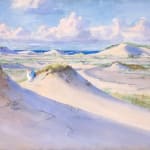John Whorf 1903-1959
Sand Dunes, Cape Cod
Watercolor on paper
22 x 30 inches
55.9 x 76.2 cm
Framed dimensions: 28 1/4 x 36 1/2 inches
55.9 x 76.2 cm
Framed dimensions: 28 1/4 x 36 1/2 inches
Signed lower right: John Whorf
Sand Dunes, Cape Cod amply demonstrates John Whorf’s expert handling of the watercolor medium. The fluidity of his style is most notable here in the play between the transparent and...
Sand Dunes, Cape Cod amply demonstrates John Whorf’s expert handling of the watercolor medium. The fluidity of his style is most notable here in the play between the transparent and opaque applications of paint. Not only does this technique create an interesting composition but it also helps to capture the energy of the landscape. Whorf uses washes of color to build the solid forms and capture the transient effects of light. His masterful array of brushwork and bold use of color invites his viewer to experience the mood of the landscape, as if he or she is experiencing it firsthand.
John Whorf was born in Boston in 1903. His father, Harry Whorf, was an artist and graphic designer. When John decided at a young age to become an artist himself, his father provided early instruction and encouragement. When he was 14, Whorf enrolled in art classes at the St. Botolph Studio and the Museum of Fine Arts School, but ultimately he eschewed formal training, opting instead to simply “paint.” As with most artists, Whorf longed to travel abroad. After recovering from an accident that left him temporarily paralyzed, he set out on his first journey to Europe at the age of eighteen. During that time, he began painting with watercolor, and found that it suited him and his lifestyle better than oils. A difficult medium to master, watercolor requires that an artist work quickly, almost intuitively.
Whorf’s ability to capture natural colors and blend them with shadow and light earned him renown. In 1924 he had his first one-man show at the Grace Horne Gallery in Boston. More than fifty of his paintings sold during that exhibition, and his reputation as a leading watercolorist was secured. Throughout his life, Whorf exhibited in galleries in New York and Boston. And in 1947 he was elected as a member of the National Academy of Design.
John Whorf was born in Boston in 1903. His father, Harry Whorf, was an artist and graphic designer. When John decided at a young age to become an artist himself, his father provided early instruction and encouragement. When he was 14, Whorf enrolled in art classes at the St. Botolph Studio and the Museum of Fine Arts School, but ultimately he eschewed formal training, opting instead to simply “paint.” As with most artists, Whorf longed to travel abroad. After recovering from an accident that left him temporarily paralyzed, he set out on his first journey to Europe at the age of eighteen. During that time, he began painting with watercolor, and found that it suited him and his lifestyle better than oils. A difficult medium to master, watercolor requires that an artist work quickly, almost intuitively.
Whorf’s ability to capture natural colors and blend them with shadow and light earned him renown. In 1924 he had his first one-man show at the Grace Horne Gallery in Boston. More than fifty of his paintings sold during that exhibition, and his reputation as a leading watercolorist was secured. Throughout his life, Whorf exhibited in galleries in New York and Boston. And in 1947 he was elected as a member of the National Academy of Design.
Provenance
Private collectionPlease join our mailing list
* denotes required fields
We will process the personal data you have supplied in accordance with our privacy policy (available on request). You can unsubscribe or change your preferences at any time by clicking the link in our emails.



